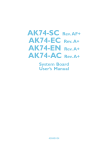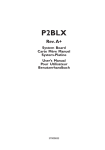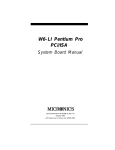Download Rev. AH+ System Board User's Manual
Transcript
P2XLX Rev. AH+ System Board Users Manual 34530832 Copyright This publication contains information that is protected by copyright. No part of it may be reproduced in any form or by any means or used to make any transformation/adaptation without the prior written permission from the copyright holders. This publication is provided for informational purposes only. The manufacturer makes no representations or warranties with respect to the contents or use of this manual and specifically disclaims any express or implied warranties of merchantability or fitness for any particular purpose. The user will assume the entire risk of the use or the results of the use of this document. Further, the manufacturer reserves the right to revise this publication and make changes to its contents at any time, without obligation to notify any person or entity of such revisions or changes. All Rights Reserved. © 1998 Trademarks Microsoft® MS-DOS®, WindowsTM and Windows® 95 are registered trademarks of Microsoft Corporation. Intel®, Pentium® II and CeleronTM are registered trademarks of Intel Corporation. Award is a registered trademark of Award Software, Inc. Other trademarks and registered trademarks of products appearing in this manual are the properties of their respective holders. Caution: Danger of explosion if battery incorrectly replaced. Replace only with the same or equivalent type recommended by the manufacturer. Dispose of used batteries according to the battery manufacturers instructions. FCC and DOC Statement on Class B This equipment has been tested and found to comply with the limits for a Class B digital device, pursuant to Part 15 of the FCC rules. These limits are designed to provide reasonable protection against harmful interference when the equipment is operated in a residential installation. This equipment generates, uses and can radiate radio frequency energy and, if not installed and used in accordance with the instruction manual, may cause harmful interference to radio communications. However, there is no guarantee that interference will not occur in a particular installation. If this equipment does cause harmful interference to radio or television reception, which can be determined by turning the equipment off and on, the user is encouraged to try to correct the interference by one or more of the following measures: Reorient or relocate the receiving antenna. Increase the separation between the equipment and the receiver. Connect the equipment into an outlet on a circuit different from that to which the receiver is connected. Consult the dealer or an experienced radio TV technician for help. Notice: 1. The changes or modifications not expressly approved by the par ty responsible for compliance could void the user's authority to operate the equipment. 2. Shielded interface cables must be used in order to comply with the emission limits. Table of Contents Chapter 1 - Introduction 1.1 Features and Specifications................................................................................... 7 1.2 Package Checklist.......................................................................................................... 12 Chapter 2 - Hardware Installation 2.1 System Board Layout .............................................................................................. 2.2 Installation Steps............................................................................................................. 2.2.1 Installing System Memory..................................................................... 2.2.2 Installing a Processor................................................................................. 2.2.3 Setting the Jumpers on the System Board......................... 2.2.4 Installing Expansion Cards................................................................... 2.2.5 Connecting the Ribbon Cables and Wires of the Ports and Connectors.............................................................. 2.2.6 Installing the System Board.................................................... 14 15 15 17 26 27 29 40 Chapter 3 - Award BIOS Setup Utility 3.1 The Basic Input/Output System...................................................................... 3.1.1 Standard CMOS Setup.................................................................... 3.1.2 BIOS Features Setup.......................................................................... 3.1.3 Chipset Features Setup.................................................................... 3.1.4 Power Management Setup............................................................ 3.1.5 PNP/PCI Configuration..................................................................... 3.1.6 Load Fail-Safe Settings...................................................................... 3.1.7 Load Optimal Settings.......................................................... 3.1.8 Integrated Peripherals........................................................... 3.1.9 Supervisor Password............................................................ 3.1.10 User Password......................................................................... 3.1.11 IDE HDD Auto Detection................................................ 3.1.12 Save & Exit Setup................................................................... 3.1.13 Exit Without Saving................................................................ 42 42 46 50 52 55 57 58 58 61 62 62 63 63 Chapter 4 - Supported Softwares 4.1 Desktop Management Interface...................................................................... 65 4.2 System Health Monitor Utility............................................................................ 69 4.3 IDE Drivers......................................................................................................................... 70 Appendix A - System Error Messages A.1 POST Beep....................................................................................................................... 72 A.2 Error Messages............................................................................................ 72 Appendix B - Troubleshooting B.1 Troubleshooting Checklist...................................................................................... 75 1 P2XLX System Board Users Manual CHAPTER 1 Introduction 6 Introduction 1.1 Features and Specifications 1.1.1 Features Chipset Intel 440LX AGPset Processor The system board is equipped with a 242-pin Intel Slot 1 processor slot for installing an Intel Pentium II processor that is packaged in an SEC (Single Edge Contact) cartridge. 233/266/300/333MHz Pentium II processor 266/300/300A/333 CeleronΤΜ processor System Memory The system board supports 8MB to 384MB using unbuffered SDRAM or EDO memory. It is equipped with three 168-pin DIMM sockets using x64/x72 EDO (50/60ns) or SDRAM (10/12/ 13ns), 3.3V. It also supports EC and ECC (uses x72 DRAM). Expansion Slots The system board is equipped with 1 dedicated AGP slot, 3 dedicated PCI slots, 2 dedicated 16-bit ISA slots and 1 shared PCI/ ISA slot. All PCI and ISA slots are bus masters. Desktop Management Interface (DMI) The system board comes with a DMI 2.0 built into the BIOS. The DMI utility in the BIOS automatically records various information about your system configuration and stores these information in the DMI pool, which is a part of the system board's Plug and Play BIOS. DMI, along with the appropriately networked software, is designed to make inventory, maintenance and troubleshooting of computer systems easier. Refer to Chapter 4 for instructions on using the DMI utility. 7 1 1 P2XLX System Board Users Manual Onboard I/O Two NS16C550A-compatible DB-9 serial ports One SPP/ECP/EPP DB-25 parallel port One floppy drive interface supports up to two 2.88MB floppy drives One mini-DIN-6 PS/2 mouse port One mini-DIN-6 PS/2 keyboard port One WOL (Wake-On-LAN) connector PCI Bus Master IDE Controller Two PCI IDE interfaces support up to four IDE devices Ultra DMA/33 supported (Synchronous Ultra DMA mode data transfer rate up to a maximum of 33MB/sec.) PIO Mode 3 and Mode 4 Enhanced IDE (data transfer rate up to 16.6MB/sec.) Bus mastering reduces CPU utilization during disk transfer ATAPI CD-ROM supported LS-120 and ZIP supported IrDA Interface The system board is equipped with an IrDA connector for wireless connectivity between your computer and peripheral devices. It supports peripheral devices that meet the IrDA or ASKIR standard. USB Ports The system board is equipped with two USB ports. USB allows data exchange between your computer and a wide range of simultaneously accessible external Plug and Play peripherals. BIOS Award BIOS, Windows 95 Plug and Play compatible Flash EPROM for easy BIOS upgrades 8 Introduction ATX Power Supply Connector The system board is equipped with an ATX power supply connector. Using an ATX power supply, you can either shut down your computer by pressing the Power button located on the front bezel of your computer or by executing the Shut Down command under the Windows 95 operating system. Your system will then enter the Soft Off state. To power-on your system automatically, enable Resume By Alarm in the Power Management Setup of the Award BIOS. This will allow you to set the date and time you would like your system to poweron. 1.1.2 Technology AGP (Accelerated Graphics Port) The system board is equipped with 1 AGP slot. AGP is an interface designed to support high performance 3D graphics cards. It utilizes a dedicated pipeline to access system memory for texturing, z-buffering and alpha blending; delivering up to 533MB/sec. bandwidth for 3D graphics applications. AGP in this Pentium II processor based system board will deliver faster and better graphics with your PC. SDRAM (Synchronous Dynamic Random Access Memory) The system board supports unbuffered SDRAM memory. SDRAM is a DRAM technology that uses the clock on the chip to synchronize with the CPU clock so that the timing of the memory chips and the timing of the CPU are synchronized. This saves time during transmission of data, subsequently increasing system performance. Ultra DMA/33 Bus Master IDE Synchronous Ultra DMA mode provides data transfer rate up to a maximum of 33MB/sec, which is twice the data transfer rate of Enhanced IDE or ATA-2. This enables the CPU to operate more efficiently when handling simultaneous events. 9 1 1 P2XLX System Board Users Manual ECC (Error Checking and Correction) ECC is a function that allows the system to recover from memory failure. It detects single-bit and multiple-bit errors and corrects singlebit error thus providing uninterrupted processing of data. To use this function, you must install DIMM that supports parity. Refer to the Installing System Memory section in Chapter 2 of this manual. ACPI (Advanced Configuration and Power Interface) The system board is designed to meet the ACPI specification. ACPI has energy saving features that enables PCs to implement Power Management and Plug-and-Play with operating systems that support OS Direct Power Management. PC 97 Compliant The system board is PC 97 compliant. This will optimize your PC system to run Windows 95 and Windows NT and future versions of these operating systems. 1.1.3 Intelligence Monitors Processor Temperature and Overheat Alarm The system board is able to detect the temperature of the processor. An alarm will sound in case of processor overheat. Refer to Chipset Features Setup (Chapter 3) and System Health Monitor Utility (Chapter 4) for more information. Monitors Processor/Chassis Fan Speed and Failure Alarm The system board is able to detect the fan speed (RPM-Revolution Per Minute) and alerts you to attend to any irregularity that may damage your system. Refer to Chipset Features Setup (Chapter 3) and System Health Monitor Utility (Chapter 4) for more information. Monitors Power Voltages and Failure Alarm The system board is able to detect the output voltage of the power supply. An alarm will sound warning you of voltage irregularity. Refer to Chipset Features Setup (Chapter 3) and System Health Monitor Utility (Chapter 4) for more information. 10 Introduction Automatic Fan Control With the systems power switched on, the processors fan will rotate only if the temperature of the processor is over 25oC. This saves energy, prevents system overheat, prolongs fan life and implements a silent system. Dual Function Power Button Depending on the setting in the BIOS setup, this switch will allow your system to enter the Soft-Off or Suspend mode. Soft-Off By PWR-BTTN in the Power Management Setup (Chapter 3) allows you to select the method of powering off your system. External Modem Ring-on The Modem Ring-on feature allows the sleeping (Suspend mode) or Soft Power Down (Soft-Off) PC to power-on to respond to incoming calls. Enable this function in the Resume By Ring/LAN field of the Power Management Setup (Chapter 3). Note: This feature supports external modem only. RTC Timer to Power-on the System The RTC installed on the system board allows your system to automatically power-on on the set date and time. Set the date and time you would like your system to power-on in the Resume By Alarm field of the Power Management Setup (Chapter 3). Wake-On-LAN Ready The Wake-On-LAN function allows the network to power-on a Soft Power Down (Soft-Off) PC. To use the Wake-On-LAN function, make sure your LAN card also support this function. Refer to the Wake-On-LAN Connector section (Chapter 2) and Resume By Ring/LAN field in the Power Management Setup (Chapter 3) for more information. 11 1 1 P2XLX System Board Users Manual Virus Protection Most viruses today destroy data stored in hard drives. The system board is designed to protect the boot sector and partition table of your hard disk drive. If an attempt is made to write to the boot sector or partition table of the hard disk drive, the BIOS will halt the system and an error message will appear. Refer to the Virus Warning field in the BIOS Features Setup (Chapter 3) for more information. 1.2 Package Checklist The system board package contains the following items: þ þ þ þ þ þ þ The system board A users manual One 40-pin IDE hard disk cable One 34-pin floppy disk drive cable One CD One I/O shield Five spare jumpers If any of these items are missing or damaged, please contact your dealer or sales representative for assistance. 12 CHAPTER 2 Hardware Installation 2 P2XLX System Board Users Manual 2.1 System Board Layout 14 Hardware Installation 2.2 Installation Steps Warning: Electrostatic discharge (ESD) can damage your system board, processor, disk drives, add-in boards, and other components. Perform the upgrade instruction procedures described at an ESD workstation only. If such a station is not available, you can provide some ESD protection by wearing an antistatic wrist strap and attaching it to a metal part of the system chassis. If a wrist strap is unavailable, establish and maintain contact with the system chassis throughout any procedures requiring ESD protection. The following outlines the basic installation steps prior to installing the system board into the chassis. 2.2.1 Install the System Memory 2.2.2 Install the Processor 2.2.3 Set the Jumpers on the System Board 2.2.4 Install the Expansion Cards 2.2.5 Connect the Ribbon Cables and Wires of the Ports and Connectors 2.2.6 Install the System Board 2.2.1 Installing System Memory The system board is equipped with three 168-pin DIMM (Dual In-line Memor y Module) sockets. It suppor ts 8MB to 384MB memory using x64/x72 unbuffered SDRAM or EDO DIMM, 3.3V. The system board supports the Error Checking and Correction (ECC) function. To use this function, you must install DIMM 15 2 2 P2XLX System Board Users Manual that supports parity. That is, DIMM that typically has 9 memor y chips per side. This kind of module has 8 standard memory cihps and a parity chip. DIMM with no parity has 8 standard memor y chips only. The table below shows the suppor ted DIM modules and their corresponding memory sizes. You may install DIMM in any DIMM sockets. Memory size and speed can vary between sockets. The BIOS will automatically detect the memory type, size and speed. DIMMs Memory Size 1MBx64/x72 8MB 2MBx64/x72 16MB 4MBx64/x72 32MB 8MBx64/x72 64MB 16MBx64/x72 128MB Installing the DIM Module A DIM module simply snaps into a socket on the system board. Pin 1 of the DIM module must correspond with Pin 1 of the socket. Notch Tab Pin 1 Tab Key 1. Pull the tabs which are at the ends of the socket to the side. 2. Position the DIMM above the socket with the notches in the module aligned with the keys on the socket. 3. Seat the module ver tically into the socket. Make sure it is completely seated. The tabs will hold the DIMM in place. 16 Hardware Installation 2.2.2 Installing a Processor The system board is equipped with a 242-pin processor slot for installing an Intel Pentium II processor that is packaged in an SEC (Single Edge Contact) cartridge. Warning: The processor must be kept cool by using a fan with heatsink. Leave certain space clearances to maintain proper airflow once the processor and heatsink are installed. All cables (for floppy drive, hard drive, CD-ROM, etc.) must be routed clear of the processor and its airspace. Otherwise, the processor will overheat and damage the processor and the system board. 2.2.2.1 Installing the Retention Mechanism The system board comes with an easy-to-install Retention Mechanism package. The Retention Mechanism is used to hold an Intel Pentium ® II processor to the processor slot. Make sure the system board is on a workbench (not in the chassis). To install the Retention Mechanism, follow the steps below. 1. Unpack the Retention Mechanism package. 17 2 2 P2XLX System Board Users Manual 2. Hold the Retention Mechanism upright and position it above the processor slot. 3. Now slide the Retention Mechanism downward so that it fits over the processor slot. Firmly press the ends of the Retention Mechanism until it snaps into place. The Retention Mechanism will only fit in one direction. It has a keying mechanism so that the notch on one of the inner side of the Retention Mechanism will fit into the key on one side of the processor slot. 4. Firmly press the "pins" located at the 4 corners of the Retention Mechanism to as far as it will go. These pins will stabilize the Retention Mechanism onto the system board. 18 Hardware Installation 2.2.2.2 Installing Boxed Processor 1. Mount the two black plastic pegs onto the system board. These pegs will be used to attach the fan heatsink supports. Notice that one hole and the base of one peg are larger than the other hole and peg base. Push each peg into its hole firmly until you hear it click into place. Retention mechanism Large peg and hole 2. Slide a black plastic heatsink support onto each end of the fan heatsink, making sure that the hole and clip are on the outside edge of the suppor t. (If the supports are reversed, the holes will not line up with the pegs on the system board). Slide each heatsink support toward the center of the processor until the suppor t is seated in the outside groove in the fan housing. Top of processor Heatsink suppor t Hole and clip on outside edge Attached fan/heatsink Outside groove in fan housing 19 2 2 P2XLX System Board Users Manual 20 3. Slide the clip (A) on each suppor t toward the processor, exposing the hole that will fit over the peg on the system board. Push the latches (B) on the processor toward the center of the processor until they click into place. 4. Hold the processor so that the fan shroud is facing toward the pegs on the system board. Slide the processor (C) into the Retention Mechanism and slide the suppor ts onto the pegs. Ensure that the pegs on the system board slide into the holes in the heatsink suppor t and that the alignment notch in the processor fits over the plug in the processor slot. Push the processor down firmly, with even pressure on both sides of the top, until it is seated. 5. Slide the clips on the suppor ts (A) forward until they click into place to hold the pegs securely. (Apply slight pressure on the peg and push the peg toward the clip while pushing the clip forward.) Push the latches on the processor (B) outward until they click into place in the Retention Mechanism. The latches must be secured for proper electrical connection of the processor. 6. Attach the small end of the power cable (C) to the three-pin connector in the processor, then attach the large end to the three-pin connector (J4 - fan connector) on the system board. Hardware Installation Removing the Processor To remove the processor from the system board, follow these steps (the reverse of the installation process). 1. Disconnect the fan power cable from the system board. (We recommend that you leave the cable connected to the processor). 2. Slide the clips on the supports backward to release the pegs in the system board. Push the latches on the processor toward the center of the processor until they click into place. 3. Lift one end of the processor until it is freed from the processor slot. Lift the other end of the processor until it is freed from the processor slot. Lift the entire processor (with the fan heatsink supports attached) until it is free from the Retention Mechanism. 4. Remove the heatsink suppor t pegs from the system board and discard them. With one hand, squeeze together the two halves of the peg on the bottom side of the system board. With the other hand, pull the peg out of the hole in the system board. Do not reuse the pegs. Caution: When handling the processor, avoid placing direct pressure on the label area of the fan. When removing the processor, avoid pressing down on the system board or components. Instead, press down on plastic connectors. 21 2 2 P2XLX System Board Users Manual 2.2.2.3 Installing OEM Processor If you are using Intel Pentium II processor in OEM package, please follow the steps below. 1. Your OEM package may include the following items. Heatsink Processor HSS Top Bar HSS Base HSS Support Important: Make sure your heatsink is attached with a fan to prevent overheating the processor. Contact your heatsink manufacturer to check whether your processor requires a Heatsink Support (HSS) installed on the system board. 2. Push the HSS Top Bar sideways to free the HSS Top Bar from the retaining tabs of the HSS Base. HSS Base Retaining tab HSS Top Bar 22 Hardware Installation 3. Remove the HSS Pins located on each end of the HSS Base. HSS Pin HSS Pin HSS Base 4. Install the HSS Base by pushing each side down firmly into the holes on the system board. (The HSS Base can only be installed in one direction). Make sure it locks into place. 5. Replace the HSS Pins on each end of the HSS Base. These pins will inser t through the HSS Base to secure it to the system board. 6. Hold the processor and push the latches toward the center of the processor until they click into place. 7. Hold the processor so that the heatsink is facing toward the HSS Base on the system board. Slide the processor into the Retention Mechanism. Ensure that the alignment notch in the processor fits into the plug in the processor slot. Push the processor down firmly, with even pressure on both sides of the top, until it is seated. 23 2 2 P2XLX System Board Users Manual 8. Push the latches on the processor outward until they click into place in the Retention Mechanism. The latches must be secured for proper electrical connection of the processor. 9. Slide the HSS Top Bar into the heatsink until it locks into place. 10. Attach the small end of the power cable (C) to the three-pin connector in the processor, then attach the large end to the three-pin connector (J4 - fan connector) on the system board. 24 Hardware Installation 2.2.2.4 Jumper Settings of the Processors Make sure JP2 is set correctly before applying power or you may damage the processor or system board. Use a needle-nosed plier to move the jumper if necessary. Processor JP2 Pins 1-2 Pins 3-4 Pins 5-6 Pins 7-8 233MHz-66MHz-3.5x Off Off On On 266MHz-66MHz-4x* On On Off On 300MHz-66MHz-4.5x Off On Off On 333MHz-66MHz-5x On Off Off On * Default Note: Intel Pentium II processors or Intel CeleronTM processors support VID (Voltage Identification). The switching voltage regulator on the system board will automatically set the voltage regulator according to the voltage of the processor. 25 2 2 P2XLX System Board Users Manual 2.2.3 Setting the Jumpers on the System Board 2.2.3.1 Jumper Settings for CMOS Clear Jumper JP6 CMOS Clear If, for some reason, the CMOS data becomes corr upted, the system can be reconfigured with the default values stored in the ROM BIOS. To load the default values, power off your system and unplug the power cord. Set JP6 pins 2 and 3 to On. Wait for a few seconds and set JP6 back to its default setting, pins 1 and 2 On. You may now plug the power cord and power-on your system. 1 2 3 1-2 On: Normal (default) 26 1 2 3 2-3 On: Clear CMOS Data Hardware Installation 2.2.4 Installing Expansion Cards 1. Switch off your computers power. 2. Remove your computers cover. 3. Locate for a free expansion slot on the system board. Remove the screw and slot cover. Save the slot cover for future use. You will be using the screw in step 6. 4. Unpack the expansion card. 5. Refer to the expansion cards users manual for any hardware settings such as jumpers. 6. Position the expansion card above the free slot. When the cards edge-connector is aligned with the slot, press firmly on the top of the card to seat it. Secure it with the screw you removed in step 3. 7. Replace the computers cover and switch on the power. 2.2.4.1 Assigning an IRQ for an Expansion Card If your expansion card need an IRQ, make sure to assign an IRQ that has not been used yet. Refer to the expansion card manual to determine whether an IRQ is needed. The system has a total of 16 IRQs but most of them have been used by different components on the system leaving only 6 free IRQs available for expansion cards. There are 2 types of ISA cards: Legacy (configured manually using jumpers) and PnP (IRQs are assigned automatically). When both types of cards exist, assign an IRQ for the Legacy cards first. The PnP card will then automatically be assigned an IRQ that has not been used by the Legacy cards. After all ISA cards have been assigned an IRQ, the PCI cards will then be automatically assigned an IRQ. Refer to the Resources Controlled By field in the PNP/PCI Configuration setup of the Award BIOS for more information. 27 2 2 P2XLX System Board Users Manual To view the used and free IRQs, run Microsofts Diagnostic, MSD.EXE. MSD.EXE is in the Windows director y. If you are using Windows 95, double-click My Computer in the Windows 95 desktop. In My Computer, select Control Panel. In Control Panel, select System. In System, select Device Manager. In Device Manager, select a device to view the interrupt and IRQ used. 2.2.4.2 Assigning a DMA Channel for an Expansion Card The same method (described above) is applied when assigning a DMA channel to an expansion card. Refer to the Resources Controlled By field in the PNP/PCI Configuration setup of the Award BIOS for more information. 2.2.4.3 Expansion Slots The system board is equipped with 1 dedicated AGP slot to support high performance 3D graphics cards. Refer to the Technology section (Chapter 1) for more information. The system board is also equipped with 3 dedicated PCI slots, 2 dedicated 16-bit ISA slot and 1 shared PCI/ISA slot. All PCI and ISA slots are bus masters. 28 Hardware Installation 2.2.5 Connecting the Ribbon Cables and Wires of the Ports and Connectors 2.2.5.1 Serial Ports The built-in serial ports are RS-232C asynchronous communication por ts with 16C550A-compatible UARTs that can be used with modems, serial printers, remote display terminals, and other serial devices. You can set the serial ports I/O address in the Integrated Peripherals setup of the Award BIOS. 2.2.5.2 PS/2 Mouse Port The PS/2 mouse port uses IRQ12. If a mouse is not connected to this port, the system will reser ve IRQ12 for other expansion cards. 29 2 2 P2XLX System Board Users Manual 2.2.5.3 Parallel Port The system board has a standard printer port for interfacing your PC to a parallel printer. It suppor ts SPP, ECP and EPP modes. You can set the por ts mode in the Integrated Peripher als setup of the Award BIOS. Setting Function SPP (Standard Parallel Port) Allows normal speed operation but in one direction only. ECP (Extended Capabilities Por t) Allows parallel port to operate in bidirectional mode and at a speed faster than the SPPs data transfer rate . EPP (Enhanced Parallel Port) Allows bidirectional parallel port operation at maximum speed. 2.2.5.4 Floppy Disk Drive Controller The system board is equipped with a shrouded floppy disk header that supports two standard floppy disk drives. To prevent improper floppy cable installation, the shrouded floppy disk header has a keying mechanism. The 34-pin connector on the floppy cable can be placed into the header only if pin 1 of the connector is aligned with pin 1 of the header. 30 Hardware Installation Connecting the Floppy Disk Cable 1. Install the 34-pin header connector into the shrouded floppy disk header (J6) on the system board. The colored edge of the ribbon should be aligned with pin 1 of J6. 2. Install the other 34-pin header connector(s) into the disk drive(s). Align the colored edge of the daisy chained ribbon cable with pin 1 of the drive edge connector(s). The end-most connector should be attached to the drive you want to designate as Drive A. 2.2.5.5 IDE Hard Disk Interface The system board is equipped with two shrouded PCI IDE headers that will interface four Enhanced IDE (Integrated Drive Electronics) hard disk drives. To prevent improper IDE cable installation, each shrouded PCI IDE header has a keying mechanism. The 40-pin connector on the IDE cable can be placed into the header only if pin 1 of the connector is aligned with pin 1 of the header. Note: An IDE cable with a standard 40-pin connector (without the keying mechanism) can be installed in the shrouded IDE header. Be extremely careful to match the colored edge of the ribbon with pin 1 of the header. 31 2 2 P2XLX System Board Users Manual Connecting the Hard Disk Cable 1. If you are connecting two hard drives, install the 40-pin connector of the IDE cable into the pr imar y shrouded IDE header (connector J8). If you are adding a third or four th IDE device, install the 40-pin connector of the other IDE cable into the secondary shrouded IDE header (connector J7). 2. Install the other 40-pin header connector(s) into the device with the colored edge of the ribbon cable aligned with pin 1 of the drive edge connector(s). Note: Refer to your disk drive users manual for information about selecting proper drive switch settings. Adding a Second IDE Hard Drive When using two IDE drives, one must be set as the master and the other as the slave. Follow the instructions provided by the drive manufacturer for setting the jumpers and/or switches on the drives. We recommend that you use Enhanced IDE or ATA-2, ATA-3 and Ultra DMA hard drives be from the same manufacturer. In a few cases, drives from two different manufacturers will not function properly when used together. The problem lies in the hard drives, not the system board. Important: If you encountered problems while using an ATAPI CD-ROM drive that is set in Master mode, please set the CD-ROM drive to Slave mode. Some ATAPI CD-ROMs may not be recognized and cannot be used if incorrectly set in Master mode. Preparing an IDE Drive for Use IDE disk drives are already low-level formatted, with any bad-track errors entered, when shipped by the drive manufacturer. Do not attempt to do a low-level format or you may cause serious damage to the drive. 32 Hardware Installation To use an IDE drive, you need to enter the drive type (this information is provided by the drive manufacturer) into the systems CMOS setup table. Then run FDISK and FORMAT provided with your operating system. You may also use the IDE HDD Auto Detection function which will allow the BIOS to auto detect your hard drive type. Refer to the Chapter 3 - IDE HDD Auto Detection section for details. Warning: Do not run FDISK and FORMAT programs on a drive that has already been formatted or you will lose all programs and data stored on the drive. 2.2.5.6 Universal Serial Bus Ports The system board is equipped with two USB por ts. USB allows data exchange between your computer and a wide range of simultaneously accessible external Plug and Play peripherals. You must have the proper drivers installed in your operating system to use these por ts. Refer to your operating systems manual or documentation. 33 2 2 P2XLX System Board Users Manual 2.2.5.7 IrDA Connector The system board is equipped with an IrDA connector for wireless connectivity between your computer and peripheral devices. Connect your IrDA cable to connector J10 on the system board. Refer to UART2 Mode Select in the Integrated Peripherals setup (Chapter 3) for more information. You must have the proper drivers installed in your operating system to use this connector. Refer to your operating systems manual or documentation. Pin Function 1 IRTX 2 GND 3 IRRX 4 IRR3 5 VCC 2.2.5.8 CPU Fan Connector The processor must be kept cool by using a fan with heatsink. Connect the CPU fan to the 3-pin fan connector at location J4 on the system board. 34 Pin Function 1 GND 2 +12V 3 Sense Hardware Installation 2.2.5.9 Chassis Fan Connector The system board is equipped with a chassis fan connector. If you are installing a fan in the system unit, connect the fans connector to location J5 on the system board. The fan will provide adequate airflow throughout the chassis to prevent overheating the processor. Pin Function 1 GND 2 +12V 3 Sense 2.2.5.10 AGP Fan Connector The system board is equipped with an AGP fan connector. If the system board is installed with an AGP add-in card and you wish to install a fan on the add-in card, connect the fans connector to location J3 on the system board. Refer to the add-in cards manual for instructions on installing the fan. Pin Function 1 GND 2 +12V 3 N.C . 35 2 2 P2XLX System Board Users Manual 2.2.5.11 J9 (LEDs and Switches) SB-LED (ATX 5VSB Standby LED) Pin 1 Pin 2 LED Power Ground HD-LED (Primary/Secondary IDE LED) Pin 1 Pin 2 LED Power Signal G-LED (Green LED) Pin 1 Pin 2 LED Power Signal SP-SW (ATX power switch) Pin 1 Pin 2 Signal Ground G-SW (Green switch) Pin 1 Pin 2 Signal Ground RESET (Reset switch) Pin 1 Pin 2 Signal Ground SPEAKER (Speaker connector) Pin Pin Pin Pin 1 2 3 4 Signal N.C. Ground +5V KEYLOCK (Keylock Connector) Pin Pin Pin Pin Pin 1 2 3 4 5 LED Power N.C. Ground Keylock Signal Ground Use pins 1 and 3 for the Power LED. 36 Hardware Installation ATX 5VSB Standby LED This LED will light when the 5VSB power is active. Primary/Secondary IDE LED This LED will light when the hard drive is being accessed. Green LED This LED will light when the system is in the Suspend mode. ATX Power Switch Depending on the setting in the BIOS setup, this switch is a dual function power button that will allow your system to enter the SoftOff or Suspend mode. Refer to Soft-Off By PWR-BTTN in the Power Management Setup (Chapter 3). Green Switch This switch will allow your system to enter the Suspend mode. To wake up the system, Reload Global Timer Events in the Power Management Setup (Chapter 3) must be enabled so that access to the specified IRQ will cause the system to wake up completely from the Suspend mode. Reset Switch This switch allows you to reboot without having to power off the system thus prolonging the life of the power supply or system. Speaker Connector This connects to the speaker installed in the system chassis. Keylock Connector This is used to connect to the keyboard lock (located on the front panel of the system chassis) for locking the keyboard. Use pins 1 and 3 to connect to the Power LED. 37 2 2 P2XLX System Board Users Manual 2.2.5.12 Wake-On-LAN (WOL) Connector The Wake-On-LAN function will allow the network to wake up a Soft Power Down (Soft-Off) PC. However, if your system is in the Suspend mode, you can wake-up the system only through an IRQ or DMA interrupt. To use this function, you must enable the Resume By Ring/LAN field in the Power Management Setup (Chapter 3) and connect the cable that comes with your LAN card to location J2 on the system board. Refer to the add-in cards manual for details. Note: Your LAN card must suppor t Magic Packet in order to use the Wake-On-LAN function. Pin Function 1 5VSB (720mA) 2 GND 3 Signal Important: The 5VSB power source of your power supply must support ≥720mA (minimum). 38 Hardware Installation 2.2.5.13 Power Connector The system board is equipped with an ATX power connector at location PL1 of the system board. Using an ATX power supply, you can either shut down your computer by pressing the Power button located on the front bezel of your computer or by executing the Shut Down command under the Windows 95 operating system. Your system will enter the soft power off state. To power-on your system automatically, enable Resume By Alarm in the Power Management Setup of the Award BIOS. This will allow you to set the date and time you would like your system to power-on. Install the 20-pin ATX power cable connector into location PL1 on the system board. The 20-pin connector can be inserted into PL1 only if pin 1 of the connector is aligned with pin 1 of PL1. Pin Function Pin Function 1 3.3V/14A 11 3.3V/14A 2 3.3V/14A 12 -12V 3 Ground 13 Ground 4 +5V 14 PS-ON 5 Ground 15 Ground 6 +5V 16 Ground 7 Ground 17 Ground 8 PW-OK 18 -5V 9 5VSB 19 +5V 10 +12V 20 +5V Important: Your power supply must meet the ATX specification supporting 3.3V/14A (minimum), otherwise your system will not boot properly. 39 2 2 P2XLX System Board Users Manual 2.2.6 Installing the System Board 1. Remove the I/O shield located at the rear of the system unit and replace it with the I/O shield included in the package. Refer to your system chassis manual for instructions on removing and installing the I/O shield. 2. Install the system board into the chassis. 3. Install all expansion cards, cables and connectors. 4. Replace the system unit cover. Reconnect all power cords and cables. 5. You may now turn on the power of your system unit. After you power up your system, the BIOS message appears on your screen and the memory count begins. After the memory test, the following message will appear on the screen: Press DEL to enter setup. If the message disappears before you respond, restar t your system or press the Reset button. You may also restart the system by pressing the <Ctr l> <Alt> and <Del> keys simultaneously. 6. Refer to Chapter 3 for descriptions on the BIOS setup. 40 CHAPTER 3 Award BIOS Setup Utility 3 P2XLX System Board Users Manual 3.1 The Basic Input/Output System The Basic Input/Output System (BIOS) is a program that takes care of the basic level of communication between the processor and peripherals. In addition, the BIOS also contain codes for various advanced features found in this system board. This chapter explains the Setup Utility for the Award BIOS. After you power up your system, the BIOS message appears on your screen and the memory count begins. After the memor y test, the following message will appear on the screen: Press DEL to enter setup If the message disappears before you respond, restar t your system or press the Reset button. You may also restart the system by pressing the <Ctrl> <Alt> and <Del> keys simultaneously. When you press <Del>, the main program screen will appear. ROM PCI/ISA BIOS CMOS SETUP UTILITY AWARD SOFTWARE, INC. STANDARD CMOS SETUP BIOS FEATURES SETUP CHIPSET FEATURES SETUP POWER MANAGEMENT SETUP PNP/PCI CONFIGURATION LOAD FAIL-SAFE SETTINGS LOAD OPTIMAL SETTINGS Esc F10 INTEGRATED PERIPHERALS SUPERVISOR PASSWORD USER PASSWORD IDE HDD AUTO DETECTION SAVE & EXIT SETUP EXIT WITHOUT SAVING : Quit : Save & Exit Setup ↑↓→← (Shift) F2 : Select Item : Change Color 3.1.1 Standard CMOS Setup Use the arrow keys to highlight Standard CMOS Setup and press <Enter>. A screen similar to the one on the next page will appear. 42 Award BIOS Setup Utility ROM PCI/ISA BIOS STANDARD CMOS SETUP AWARD SOFTWARE, INC. Date (mm:dd:yy) : Mon, Jan 5 1998 Time (hh:mm:ss) : 13: 27: 50 HARD DISKS Primary Master Primary Slave Secondary Master Secondary Slave : : : : TYPE SIZE CYLS HEAD PRECOMP LANDZ SECTOR MODE Auto 0 0 0 0 0 0 Auto Auto 0 0 0 0 0 0 Auto Auto 0 0 0 0 0 0 Auto Auto 0 0 0 0 0 0 Auto Drive A : 1.44M, 3.5 in. Drive B : None Base Memory : 640K Extended Memory : 64512K Other Memory : 384K Total Memory : 65536K Video : EGA/VGA Halt on : All Errors Esc F10 : Quit : Save & Exit Setup ↑↓→← (Shift)F2 : Select Item : Change PU/PD/+/- : Modify The settings on the screen are for reference only. Your version may not be identical to this one. Date The date format is <day>, <month>, <date>, <year>. Day displays a day, from Sunday to Saturday. Month displays the month, from January to December. Date displays the date, from 1 to 31. Year displays the year, from 1994 to 2079. Time The time format is <hour>, <minute>, <second>. The time is based on the 24-hour military-time clock. For example, 1 p.m. is 13:00:00. Hour displays hours from 00 to 23. Minute displays minutes from 00 to 59. Second displays seconds from 00 to 59. Primary Master, Primary Slave, Secondary Master and Secondary Slave These categories allow you to enter the appropriate specifications for the type of hard disk drive(s) installed in your system. Press <PgUp> or <PgDn> to select a numbered hard disk type or type the number and press <Enter>. The hard disk will not work properly if you enter improper information for this category. You can use Type User to define your own drive type manually. This information should be included in the documentation from your hard disk vendor. If you select Type Auto, the BIOS will auto-detect the HDD & CD-ROM drive at the POST stage and show the IDE for the HDD & CDROM drive. If a hard disk has not been installed, select None and press <Enter>. 43 3 3 P2XLX System Board Users Manual Drive A and Drive B These categories identify the types of floppy disk drives installed. Choosing an incorrect type might cause your system to format the floppy disk improperly and you cannot access your data. The options for drive A and B are: None 360K, 5.25 in. 1.2M, 5.25 in. 720K, 3.5 in. 1.44M, 3.5 in. 2.88M, 3.5 in. No floppy drive is installed 5-1/4 in. standard drive; 360KB capacity 5-1/4 in. AT-type high-density drive; 1.2MB capacity 3-1/2 in. double-sided drive; 720KB capacity 3-1/2 in. double-sided drive; 1.44MB capacity 3-1/2 in. double-sided drive; 2.88MB capacity Video This category selects the type of video adapter used for the primar y system monitor. Although secondary monitors are supported, you do not have to select the type in Setup. The default setting is EGA/VGA (BIOS default, Setup default). EGA/VGA CGA 40 CGA 80 Mono Enhanced Graphics Adapter/Video Graphics Array. For EGA, VGA, SVGA and PGA monitor adapters. Color Graphics Adapter. Power up in 40-column mode. Color Graphics Adapter. Power up in 80-column mode. Monochrome adapter. Includes high resolution monochrome adapters. Halt On This category determines whether the system will stop if an error is detected during power up. The default setting is All, But Keyboard (BIOS default, Setup default). No Errors The system boot will not stop for any errors detected. All Errors The system boot will stop whenever the BIOS detects a non-fatal error. All, But Keyboard The system boot will not stop for a keyboard error; it will stop for all other errors. All, But Diskette The system boot will not stop for a disk error; it will stop for all other errors. All, But Disk/Key The system boot will not stop for a disk or keyboard error; it will stop for all other errors. 44 Award BIOS Setup Utility Memory The base memory size, extended memory size and the other memory size cannot be altered; your computer automatically detects and displays them. Base Memory The POST will determine the amount of base (or conventional) memor y installed in the system. The value of the base memor y is typically 512K for systems with 512K memor y installed on the motherboard or 640K for systems with 640K or more memory installed on the motherboard. Extended Memory The BIOS determines how much extended memory is present during the POST. This is the amount of memory located above 1MB in the CPUs memory address map. Other Memory This refers to the memory located in the 640K to 1024K address space. This is the memor y that can be used for different applications. DOS uses this area to load device drivers in an effor t to keep as much base memory free for application programs. The BIOS is the most frequent user of this RAM area since this is where it shadows the ROM. 45 3 3 P2XLX System Board Users Manual 3.1.2 BIOS Features Setup The BIOS Features Setup allows you to configure your system for basic operation. Some entries are defaults required by the system board, while others, if enabled, will improve the performance of your system or let you set some features according to your preference. ROM PCI/ISA BIOS BIOS FEATURES SETUP AWARD SOFTWARE, INC. Virus Warning : CPU L1 Cache : CPU L2 Cache : Quick Power On Self Test : Boot Sequence : Swap Floppy Drive : Boot Up Floppy Seek : Boot Up NumLock Status : Gate A20 Option : Typematic Rate Setting : Typematic Rate (Chars/Sec) : Typematic Delay (Msec) : Security Option : PCI/VGA Palette Snoop : OS Select For DRAM > 64MB : HDD S.M.A.R.T. Capability : Disabled Enabled Enabled Enabled A, C, SCSI Disabled Disabled On Fast Disabled 6 250 Setup Disabled Non-OS2 Disabled Video BIOS Shadow C8000-CBFFF Shadow CC000-CFFFF Shadow D0000-D3FFF Shadow D4000-D7FFF Shadow D8000-DBFFF Shadow DC000-DFFFF Shadow ESC F1 F5 F6 F7 : : : : : : : : : : : : Enabled Disabled Disabled Disabled Disabled Disabled Disabled Quit ↑↓→← : Select Item PU/PD/+/- : Modify Help Old Values (Shift) F2 : Color Load Fail-Safe Settings Load Optimal Settings The settings on the screen are for reference only. Your version may not be identical to this one. Virus Warning This category protects the boot sector and partition table of your hard disk drive. When this item is enabled, the Award BIOS will monitor the boot sector and partition table of the hard disk drive. If an attempt is made to write to the boot sector or partition table of the hard disk drive, the BIOS will halt the system and an error message will appear. After seeing the error message, if necessary, you will be able to run an anti-virus program to locate and remove the problem before any damage is done. Many disk diagnostic programs which attempt to access the boot sector table will cause the warning message to appear. If you are running such a program, we recommend that you first disable this category. Also, disable this category if you are installing or running cer tain operating systems like Windows® 95 or the operating system may not install nor work. 46 Award BIOS Setup Utility CPU L1 Cache and CPU L2 Cache These categories speed up the memory access. The default value is enabled. Enable the External Cache for better performance. Quick Power On Self Test This category speeds up Power On Self Test (POST) after you power on your system. When Enabled, the BIOS will shorten or skip some check items during POST. Boot Sequence This categor y determines which drive to search first for the disk operating system. The default is A, C, SCSI. The options are: A, C, SCSI; D, A, SCSI; SCSI, C, A; C, A, SCSI; E, A, SCSI; C only; C, CDROM, A; F, A, SCSI; LS120/ZIP, C. CDROM, C, A; SCSI, A, C; Swap Floppy Drive When this option is enabled and the system is booting from the floppy drive, the system will boot from drive B instead of drive A. When this option is disabled and the system is booting from the floppy drive, the system will boot from drive A. You must have two floppy drives to use this function. Boot Up Floppy Seek When enabled, the BIOS will check whether the floppy disk drive installed is 40 or 80 tracks. Note that the BIOS cannot distinguish between 720K, 1.2M, 1.44M and 2.88M drive types as they are all 80 tracks. When disabled, the BIOS will not search for the type of floppy disk drive by track number. Note that there will not be any warning message if the drive installed is 360KB. Boot Up NumLock Status This allows you to determine the default state of the numeric keypad. By default, the system boots up with NumLock on wherein the function of the numeric keypad is the number keys. When set to Off, the function of the numeric keypad is the arrow keys. 47 3 3 P2XLX System Board Users Manual Gate A20 Option This entry allows you to select how gate A20 is handled. Gate A20 is a device used to address memory above 1 Mbyte. Initially, gate A20 was handled via the keyboard controller. Today, while keyboards still provide this suppor t, it is more common, and much faster, for the system chipset to provide support for gate A20. Typematic Rate Setting When disabled, continually holding down a key on your keyboard will cause the BIOS to report that the key is down. When the typematic rate is enabled, the BIOS will not only report that the key is down, but will first wait for a moment, and, if the key is still down, it will begin to report that the key has been depressed repeatedly. For example, you would use such a feature to accelerate cursor movements with the arrow keys. Typematic Rate (Chars/Sec) This selection allows you to select the rate at which the keys are accelerated. Typematic Delay (Msec) This selection allows you to select the delay between when the key was first depressed and when the acceleration begins. Security Option System The system will not boot and access to Setup will be denied if the correct password is not entered at the prompt. Setup The system will boot, but access to Setup will be denied if the correct password is not entered at the prompt. PCI/VGA Palette Snoop It determines whether the MPEG ISA/VESA VGA Cards can work with PCI/VGA or not. The default value is Disabled. Enabled PCI/VGA working with MPEG ISA/VESA VGA cards. Disabled PCI/VGA not working with MPEG ISA/VESA VGA cards. 48 Award BIOS Setup Utility OS Select for DRAM > 64MB This item allows you to access the memor y that is over 64MB in OS/2. The options are: Non-OS/2 and OS/2. HDD S.M.A.R.T. Capability The system board suppor ts SMART (Self-Monitoring, Analysis and Reporting Technology) hard drives. SMART is a reliability prediction technology for ATA/IDE and SCSI drives. The drive will provide sufficient notice to the system or user to backup data prior to the drives failure. The default is Disabled. If you are using hard drives that suppor t S.M.A.R.T., set this field to Enabled. SMART is supported in ATA-3 or later hard drives. Video BIOS Shadow Determines whether video BIOS will be copied to RAM. Video Shadow will increase the video speed. Note that some graphics boards require that this option be disabled. The default value is Enabled. Enabled Video shadow is enabled. Disabled Video shadow is disabled. C8000-CBFFF Shadow to DC000-DFFFF Shadow These categories determine whether option ROMs will be copied to RAM. Enabled Optional shadow is enabled. Disabled Optional shadow is disabled. 49 3 3 P2XLX System Board Users Manual 3.1.3 Chipset Features Setup ROM PCI/ISA BIOS CHIPSET FEATURES SETUP AWARD SOFTWARE, INC. DRAM Speed Selection MA Wait State EDO RAS# To CAS# Delay EDO RAS# Precharge Time EDO DRAM Read Burst EDO DRAM Write Burst SDRAM RAS-to-CAS Delay SDRAM RAS Precharge Time SDRAM CAS Latency Time DRAM Data Integrity Mode CPU-To-PCI IDE Posting System BIOS Cacheable Video BIOS Cacheable Video RAM Cacheable 8 Bit I/O Recovery Time 16 Bit I/O Recovery Time Memory Hole At 15M-16M Passive Release Delayed Transaction AGP Aperture Size (MB) : : : : : : : : : : : : : : : : : : : : Normal Slow 3 3 x333 x222 Slow Slow 3 Non-ECC Enabled Disabled Enabled Disabled 1 1 Disabled Enabled Disabled 64 CPU Bus Clock : 66 MHz Spread Spectrum Modulated : Disabled **** System Health Monitor **** Current CPU Temperature : 27o C/80o F : 4285 RPM Current CPU Fan Speed Current Chassis Fan Speed : 4137 RPM : Ignore CPU Temperature Limit : Ignore CPU Fan Speed Limit : Ignore Chassis Fan Speed Limit : Ignore +3.3V Voltage : Ignore +12V Voltage : Ignore +5V Voltage : Ignore +1.5V Voltage ESC F1 F5 F6 F7 : : : : : ↑ ↓ → ← : Select Item Quit Help PU/PD/+/- : Modify Old Values (Shift) F2 : Color Load Fail-Safe Settings Load Optimal Settings The settings on the screen are for reference only. Your version may not be identical to this one. This section gives you functions to configure the system based on the specific features of the chipset. The chipset manages bus speeds and access to system memor y resources. It also coordinates communications between the conventional ISA bus and the PCI bus. These items should not be altered unless necessary. Depending on your add-in cards, you may not or should not enable some of those features. The default settings have been chosen because they provide the best operating conditions for your system. The only time you might consider making any changes would be if you discovered some incompatibility or that data was being lost while using your system. Note: The system board comes with a System Health Monitor utility. Once this utility is installed, the system will ignore the settings in the System Health Monitor field of the Chipset Features Setup. If you are using Windows 95 or Windows NT 4.0, you may select between using the utility and the Chipset Features Setup. For other operating systems, you may only use the Chipset Features Setup. Refer to the System Health Monitor Utility section (Chapter 4) for more information. 50 Award BIOS Setup Utility Current CPU Temperature, Current CPU Fan Speed and Current Chassis Fan Speed These fields show the current temperature of the processor, and the current fan speed of the CPU and chassis fans in RPM (Revolutions Per Minute). CPU Temperature Limit This field allows you to manually set a limit to the processors temperature. If the temperature of the processor is over the temperature set in this field (70oC/158 oF recommended), an alarm will sound warning you of system overheat. The sound of the alarm is continuous low to high beeps. Some of the most common causes leading to high temperature are: - The fan is not functioning normally or has stopped. Turn off your system and replace the fan. The space clearance of the processor, fan and heat sink is inadequate to maintain proper airflow and heat dissipation. The chassis or cabinet has poor ventilation. CPU Fan Speed Limit and Chassis Fan Speed Limit These fields allow you to manually set a limit to the speed of the CPU and chassis fans. If the CPU/chassis fan speed is under the speed set in these fields, an alarm will sound informing you to attend to any issue that may damage your system. The sound of the alarm resembles that of the siren of an ambulance. The failure detection circuit requires a fan to operate at greater than 3600 RPM. +1.5V, +3.3V, +5V and +12V Voltages Set these fields to Monitor if you want the system board to detect the output voltage of the power supply. If the output voltage is over or under +1.5V/+3.3V/+5V/+12V (±10%), an alarm will sound warning you of voltage issue. The sound of the alarm is continuous low to high beeps but shor ter than the temperature alarm. Some of the most common causes leading to unstable output voltage of a power supply are: 51 3 3 P2XLX System Board Users Manual - The power supply is not functioning normally. Turn off your system and replace the power supply. The AC input from the power outlet to your system is unstable. Please consult your MIS depar tment or an electrician. 3.1.4 Power Management Setup The Power Management Setup allows you to configure your system to most effectively save energy. If you like to use the soft power down feature of Windows 95, you must enable the Power Management below. Select Min. Power, Max. Power or User Defined. Either one can be used as long as it is NOT disabled. ROM PCI/ISA BIOS POWER MANAGEMENT SETUP AWARD SOFTWARE, INC. Power Management : User Define PM Control by APM : Yes Video Off Method : DPMS Video Off After : Standby MODEM Use IRQ :3 Standby Mode : Disabled Suspend Mode : Disabled HDD Power Down : Disabled VGA Active Monitor : Enabled Soft-Off by PWR-BTTN : Hold 4 sec. Resume by Ring/LAN : Disabled Resume by Alarm : Disabled ** Reload Global Timer Events ** : Enabled IRQ [3-7, 9-15], NMI Primary IDE 0 : Disabled Primary IDE 1 : Disabled Secondary IDE 0 : Disabled Secondary IDE 1 : Disabled Floppy Disk : Disabled Serial Port : Enabled : Disabled Parallel Port IRQ 8 Break Suspend ESC F1 F5 F6 F7 : Disabled : : : : : Quit ↑ ↓ → ← : Select Item Help PU/PD/+/- : Modify Old Values (Shift) F2 : Color Load Fail-Safe Settings Load Optimal Settings The settings on the screen are for reference only. Your version may not be identical to this one. Power Management This category allows you to select the type (or degree) of power saving by changing the length of idle time that elapses before the Standby mode and Suspend mode are activated. Disable No power management. Disables the Standby and Suspend modes. Min. Power Saving Minimum power management. Standby Mode = 1 hr., and Suspend Mode = 1 hr. Max. Power Saving Maximum power management. Standby Mode = 1 min., and Suspend Mode = 1 min. User Defined Allows you to set each mode individually. When enabled, each option ranges from 1 min. to 1 hr. 52 Award BIOS Setup Utility PM Control by APM Yes No An Advanced Power Management device will be activated to enhance the Max. Power Saving mode and stop the CPUs internal clock. Use this option in Windows® 95. (default) The system BIOS will ignore APM when initiating the Power Management mode. Video Off Method This determines the manner in which the monitor is blanked. V/H SYNC + Blank This selection will cause the system to turn off the ver tical and horizontal synchronization ports and write blanks to the video buffer. Blank Screen This option only writes blanks to the video buffer. DPMS Initializes display power management signaling. Use this option if your video board suppor ts it. Video Off After N/A The system BIOS will never turn off the screen. Suspend The screen is off when the system is in the Suspend mode. Standby The screen is off when the system is in the Standby mode. Doze The screen is off when the system is in the Doze mode. MODEM Use IRQ This category is used to set an IRQ channel (IRQ 3, 4, 5, 7, 9, 10 or 11) for the modem installed in your system. Standby Mode This is user configurable only when the Power Management category is set to User Defined. When enabled and after the set time of system inactivity, the CPU clock will r un at a speed slower than the speed during Doze mode (1/3 of full speed) while all other devices still operate at full speed. 53 3 3 P2XLX System Board Users Manual Suspend Mode This is user configurable only when the Power Management categor y is set to User Defined. When enabled and after the set time of system inactivity, the CPU and onboard peripherals will be shut off. HDD Power Down This is user configurable only when the Power Management categor y is set to User Defined. When enabled and after the set time of system inactivity, the hard disk drive will be powered down while all other devices remain active. VGA Active Monitor Enabled VGA activities will cause the system to wake up from power saving mode. Disabled VGA activities will not cause the system to wake up from power saving mode. Soft-Off by PWR-BTTN This category allows you to select the method of powering off your system. Hold 4 Sec. Regardless of whether the Power Management field is enabled or disabled, if the power button is pushed and released in less than 4 sec, the system enters the Suspend mode. The purpose of this function is to prevent the system from powering off in case you accidentally hit or pushed the power button. Pushing the power button for more than 4 seconds will power off the system. Instant-Off Pressing and then releasing the power button at once will immediately power off your system. Resume By Ring/LAN This field suppor ts two functions. • With an external modem installed, the Modem Ring-on function allows your system to power-on to respond to incoming calls. You may connect the external modem only to the COM2 serial por t. 54 Award BIOS Setup Utility • With a LAN card installed, the Wake-On-LAN function allows the network to power-on a Soft Power Down (Soft-Off) PC. However, if your system is in the Suspend mode, you can wake up the system only through an IRQ or DMA interrupt. Refer to Wake-On LAN Connector in Chapter 2 for more information. Resume By Alarm Enabled When Enabled, you can set the date and time you would like the Soft Power Down (Soft-Off) PC to power-on. However, if the system is being accessed by incoming calls or the network (Resume By Ring/LAN) prior to the date and time set in this field, the system will give priority to the incoming calls or network. Disabled Disables the automatic wake up function. (default) IRQ 8 Break Suspend and Reload Global Timer Events When enabled, access to the specified IRQ will cause the system to wake up completely from the power management mode. When disabled, the system will not wake up from the power management mode despite access to the specified IRQ. 3.1.5 PNP/PCI Configuration This section describes configuring the PCI bus system. It covers some ver y technical items and it is strongly recommended that only experienced users should make any changes to the default settings. ROM PCI/ISA BIOS PNP/PCI CONFIGURATION AWARD SOFTWARE, INC. Resources Controlled By Reset Configuration Data : Auto : Disabled PCI IDE IRQ Map To : Primary IDE INT# : Secondary IDE INT# : Assign IRQ for VGA : Assign IRQ for USB : ESC F1 F5 F6 F7 : : : : : PCI-Auto A B Enabled Enabled Quit ↑ ↓ → ← : Select Item Help PU/PD/+/- : Modify Old Values (Shift) F2 : Color Load Fail-Safe Settings Load Optimal Settings The settings on the screen are for reference only. Your version may not be identical to this one. 55 3 3 P2XLX System Board Users Manual Resources Controlled By The Award Plug and Play BIOS has the capability to automatically configure all of the boot and Plug and Play compatible devices. Auto Manual The system will automatically detect the settings for you. The categories that follow will not be shown on the screen. This will allow you to set the IRQ/DMA (you have assigned your add-in card) to Legacy ISA or PCI/ISA PnP. For non-PnP ISA cards, select Legacy ISA. For PnP ISA or PCI cards, select PCI/ISA PnP. Reset Configuration Data Enabled The BIOS will reset the configuration data once automatically. It will then recreate a new set of configuration data. Disabled The BIOS will not reset the configuration data. PCI IDE IRQ Map To This category is used to configure your system to the type of IDE disk controller in use. PCI-Auto The system will scan and determine the PCI slot that is installed with an IDE controller card. ISA Designates the ISA slot that is installed with an IDE controller card; that is, if you are using an IDE controller card. Primary IDE INT# and Secondary IDE INT# The Primar y and Secondar y IDE INT# categories are used to select the PCI interrupt (A, B , C , or D) that is associated with the connected hard drives. 56 Award BIOS Setup Utility Assign IRQ for VGA When Enabled, the system automatically assigns an IRQ for the VGA card installed. Your VGA card will need an IRQ only when using the video capture function of the card. If you are not using this function and a new device requires an IRQ, you can set this function to Disabled. The IRQ (previously occupied by the VGA card) will be available for your new device. Note: When Disabled, a Yellow mark will appear in Windows 95s Device Manager. Assign IRQ for USB When Enabled, the system automatically assigns an IRQ for the USB device connected to your system. However, if you are not using USB devices and an ISA slot requires an IRQ, set this function to Disabled. The IRQ previously occupied by the USB device will be available for the ISA slot. Note: When Disabled, a Yellow mark will appear in Windows 95s Device Manager. 3.1.6 Load Fail-Safe Settings The Load Fail-Safe Settings option loads the troubleshooting default values permanently stored in the ROM chips. These settings are not optimal and turn off all high performance features. You should use these values only if you have hardware problems. Highlight this option on the main menu and press <Enter>. The message below will appear. Load Fail-Safe Settings (Y/N)? N If you want to proceed, type <Y> and press <Enter>. The default settings will be loaded. 57 3 3 P2XLX System Board Users Manual 3.1.7 Load Optimal Settings The Load Optimal Settings option loads optimized settings from the BIOS ROM. Use the Setup default values as standard values for your system. Highlight this option on the main menu and press <Enter>. The message below will appear. Load Optimal Settings (Y/N)? N Type <Y> and press <Enter> to load the Setup default values. 3.1.8 Integrated Peripherals ROM PCI/ISA BIOS INTEGRATED PERIPHERALS AWARD SOFTWARE, INC. IDE HDD Block Mode IDE Primary Master PIO IDE Primary Slave PIO IDE Secondary Master PIO IDE Secondary Slave PIO IDE Primary Master UDMA IDE Primary Slave UDMA IDE Secondary Master UDMA IDE Secondary Slave UDMA On-chip Primary PCI IDE On-chip Secondary PCI IDE USB Keyboard Support : : : : : : : : : : : : Enabled Auto Auto Auto Auto Auto Auto Auto Auto Enabled Enabled Disabled KBC input clock : Onboard FDC Controller: Onboard Serial Port 1 : Onboard Serial Port 2 : UART2 Mode Select : 8MHz Enabled 3F8/IRQ4 2F8/IRQ3 Normal Onboard Parallel Port Parallel Port Mode ECP Mode Use DMA EPP Mode Select 378/IRQ7 ECP+EPP 3 EPP1.7 ESC F1 F5 F6 F7 : : : : : : : : : Quit ↑ ↓ → ← : Select Item Help PU/PD/+/- : Modify Old Values (Shift) F2 : Color Load Fail-Safe Settings Load Optimal Settings The settings on the screen are for reference only. Your version may not be identical to this one. IDE HDD Block Mode Enabled The IDE HDD uses the block mode. The system BIOS will check the hard disk drive for the maximum block size the system can transfer. The block size will depend on the type of hard disk drive. Disabled The IDE HDD uses the standard mode. 58 Award BIOS Setup Utility IDE Primary Master/Slave PIO and IDE Secondary Master/Slave PIO PIO means Programmed Input/Output. Rather than have the BIOS issue a series of commands to effect a transfer to or from the disk drive, PIO allows the BIOS to tell the controller what it wants and then let the controller and the CPU perform the complete task by themselves. Your system suppor ts five modes, 0 (default) to 4, which primarily differ in timing. When Auto is selected, the BIOS will select the best available mode after checking your drive. Auto The BIOS will automatically set the system according to your hard disk drives timing. 0-4 You can select a mode that matches your hard disk drives timing. Caution: Do not use the wrong setting or you will have drive errors. IDE Primary Master/Slave UDMA and IDE Secondary Master/Slave UDMA These categories allow you to set the Ultra DMA in use. When Auto is selected, the BIOS will select the best available option after checking your hard drive or CD-ROM. Auto The BIOS will automatically detect the settings for you. Disabled The BIOS will not detect these categories. On-Chip Primary PCI IDE and On-Chip Secondary PCI IDE These categories allow you to enable or disable the primar y and secondary IDE controller. The default is Enabled. Select Disabled if you want to add a different hard drive controller. USB Keyboard Support By default, USB Keyboard Suppor t is Disabled. If you are operating under DOS, make sure to enable this function. KBC Input Clock This is used to select the input clock of your keyboard. The options are: 6MHz, 8MHz, 12MHz and 16MHz. The default is 8MHz. 59 3 3 P2XLX System Board Users Manual Onboard FDC Controller Enabled Enables the onboard floppy disk controller. Disabled Disables the onboard floppy disk controller. Onboard Serial Port 1 and Onboard Serial Port 2 Auto The system will automatically select an I/O address for the onboard serial por t 1 and serial por t 2. 3F8/IRQ4, 2F8/IRQ3, 3E8/IRQ4, 2E8/IRQ3 Allows you to manually select an I/O address for the onboard serial por t 1 and serial port 2. Disabled Disables the onboard serial por t 1 and/or serial por t 2. UART2 Mode Select The system board supports IrDA function for wireless connectivity between your computer and peripheral devices. You may not use IrDA (J10) and the COM 2 serial port (CN2) at the same time. If you are using the COM 2 serial port, make sure UART2 Mode Select is set to Normal. To use the IrDA function, follow the steps below. 1. Connect your IrDA cable to connector J10 on the system board. 2. Set UART2 Mode Select to the type of IrDA standard supported by your IrDA peripheral/device (IrDA or ASKIR). 3. The following will appear right after UART2 Mode Select. IR Transmission Delay If this option is Enabled, transmission of data will be slower. This is recommended when you encounter transmission problem with your device. The options are: Enabled and Disabled. Onboard Parallel Port 378H/IRQ7, 3BCH/IRQ7, 278H/IRQ5 Selects the I/O address and IRQ for the onboard parallel port. Disabled Disables the onboard parallel port. 60 Award BIOS Setup Utility Parallel Port Mode Parallel Port Mode will appear only if you selected an I/O address and IRQ in the Onboard Parallel Por t field. This option applies to a standard specification and will depend on the type and speed of your device. Refer to your peripherals manual for the best option. Select the parallel por t mode according to the type of printer device connected to your onboard parallel por t. The parallel modes are SPP, EPP, ECP and ECP+EPP. The default is ECP+EPP. Both ECP Mode Use DMA and EPP Mode Select will appear on the screen. If you selected EPP, EPP Mode Select will appear. This field applies to standard specification. The options are EPP1.9 and EPP1.7. Default setting: EPP1.7. If you selected ECP, ECP Mode Use DMA will appear. This is used to select a DMA channel for the parallel port. The options are 1 and 3. Default setting: 3. 3.1.9 Supervisor Password If you want to protect your system and setup from unauthorized entry, set a supervisors password with the System option selected in the BIOS Features Setup. If you want to protect access to setup only, but not your system, set a supervisors password with the Setup option selected in the BIOS Features Setup. You will not be prompted for a password when you cold boot the system. Use the arrow keys to highlight the Super visor Password option and press <Enter>. The message below will appear. Enter Password: Type in the password. You are limited to eight characters. When done, the message below will appear: Confirm Password: You are asked to verify the password. Type in exactly the same password. If you type in a wrong password, you will be prompted to enter the correct password again. To delete or disable the password function, highlight Super visor Password and press <Enter>, instead of typing in a new password. Press the <Esc> key to return to the main menu. 61 3 3 P2XLX System Board Users Manual 3.1.10 User Password If you want another user to have access only to your system but not to setup, set a users password with the System option selected in the BIOS Features Setup. If you want a user to enter a password when trying to access setup, set a users password with the Setup option selected in the BIOS Features Setup. Using users password to enter Setup allows a user to access only the User Password option that appears on the main screen. Access to all other options is denied. To set, confirm, verify, disable or delete a users password, follow the procedures described in the section Supervisor Password. If you forget your password, refer to the procedure described in the same section. 3.1.11 IDE HDD Auto Detection Use this option to detect the parameters for the hard disk drives installed in your system. These parameters will then be automatically entered into the "Standard CMOS Setup". The IDE HDD Auto Detection screen displays the following categories of information: Size, Cylinders, Heads, Precomp, LandZone, Sectors and Mode. ROM PCI/ISA BIOS CMOS SETUP UTILITY AWARD SOFTWARE, INC. HARD DISKS TYPE SIZE CYLS HEAD RECOMP LANDZ SECTOR MODE Primary Master: Select Primary Master Option (N=Skip): N OPTIONS SIZE CYLS HEAD RECOMP LANDZ 2 (Y) 1 3 853 853 853 827 1654 827 32 16 32 0 65535 65536 1653 1653 1653 SECTOR 63 63 63 MODE LBA Normal Large Note: Some OS (like SCO-UNIX) must be “NORMAL” for installation ESC: Skip The settings on the screen are for reference only. Your version may not be identical to this one. For hard drives larger than 528MB, you would typically select the LBA type. Cer tain operating systems require that you select Normal or Large. Please check your operating systems manual or Help desk on which one to select. 62 Award BIOS Setup Utility 3.1.12 Save & Exit Setup When all the changes have been made, highlight Save & Exit Setup and press <Enter>. The message below will appear: Save to CMOS and Exit (Y/N)? N Type Y and press <Enter>. The modifications you have made will be written into the CMOS memor y, and the system will reboot. You will once again see the initial diagnostics on the screen. If you wish to make additional changes to the setup, press <Ctrl> <Alt> <Esc> simultaneously or <Del> after memor y testing is done. 3.1.13 Exit Without Saving When you do not want to save the changes you have made, highlight Exit Without Saving and press <Enter>. The message below will appear : Quit Without Saving (Y/N)? N Type Y and press <Enter>. The system will reboot and you will once again see the initial diagnostics on the screen. If you wish to make any changes to the setup, press <Ctrl> <Alt> <Esc> simultaneously or <Del> after memory testing is done. 63 3 4 P2XLX System Board Users Manual CHAPTER 4 Supported Softwares 64 Supported Softwares 4.1 Desktop Management Interface (DMI) The system board comes with a DMI built into the BIOS. DMI, along with the appropriately networked software, is designed to make inventory, maintenance and troubleshooting of computer systems easier. With DMI, a network administrator or MIS engineer can remotely access some information about a par ticular computer system without physically going to it. Quite often a service call may be unnecessary as the problem can be solved remotely. The DMI utility in the BIOS automatically records various information about your system configuration. Information about the type and speed of CPU, type and amount of memor y for each memor y slot, BIOS revision level, types of add-in PCI boards and components, cer tain revision numbers of hardware installed, etc. are automatically detected and stored in the DMI pool, which is a par t of the system board's Plug and Play BIOS. Additional infor mation, such as ISA based peripherals, which may not be automatically detected, can be manually recorded in the DMI pool by using the Add DMI menu. The DMI pool data is then verified or updated whenever the system hardware or setup is altered. 4.1.1 Running the DMI Utility To run the DMI utility, type: DMICFG.EXE. You can download this utility from http://www.dfiweb.com - BIOS & DRIVERS section or ftp.dfiusa.com - /pub/DMI directory. The DMI utility must run in real mode with at least 180K of base memory. Memory managers like HIMEM.SYS (required by Windows) must not be installed. You may do this by using one of the 3 methods listed below. 1. Boot up from a system diskette without the AUTOEXEC.BAT and CONFIG.SYS files, 2. REM HIMEM.SYS in the CONFIG.SYS, or 3. Press <F5> during bootup to bypass your AUTOEXEC.BAT and CONFIG.SYS files. 65 4 P2XLX System Board Users Manual 4.1.2 Using the DMI Utility Award DMI Configuration Utility Copyright Award Software Inc, 1996 [Edit DMI] [Add DMI] [Load DMI File] [Save DMI File] ▲ ■ ▲ 4 BIOS System Enclosure/Chassis Processor Memory Controller Memory Module Memory Module Memory Module Memory Module Cache Cache Port Connector Port Connector Port Connector Port Connector Port Connector Port Connector Port Connector System Slots ↑ ↓ ← Move cursor → *** BIOS Auto Detect *** Type : BIOS Information Handle : 0000 Vendor Name : BIOS Version : BIOS Starting Address Segment : F000 BIOS Build Date : BIOS Characteristics : Size of BIOS ROM : 0128K ENTER-Accept DEL-Delete ESC-Abort&Exit The four menus located on top of the DMI Configuration Utility screen are Edit DMI, Add DMI, Load DMI File and Save DMI File. Use the ← or → (left or right) arrow keys to select a menu from the Menu bar. On the left side of the screen is a list of the system configuration items. Use the ↑ or ↓ (up or down) arrow keys to select an item. The commands at the bottom of the screen will allow you to navigate through the various setup menus. Edit DMI 1. Use the ← or → arrow keys to select the Edit DMI menu. 2. Highlight the item on the left screen that you would like to edit by using the ↑ or ↓ arrow keys, then press <Enter>. 3. The cursor will move to the screen you select allowing you to edit information. The screen will also display the auto-detected information. 4. Press <F10> to update the edited information into the flash ROM. 66 Supported Softwares Add DMI 1. Use the ← or → arrow keys to select the Add DMI menu. 2. Highlight the item on the left screen that you would like to add by using the ↑ or ↓ arrow keys, then press <Enter>. 3. The cursor will move to the screen you select allowing you to enter information about the added item. 4. Press <F10> to save information into the flash ROM. To view information about the added items, go to the Edit DMI menu. Load DMI File 1. Use the ← or → arrow keys to select the Load DMI File menu. 2. The following message will appear. Press [Enter] to select DMI file for load Press <Enter>. 3. The DMI files will appear on the screen. Select the file you would like to load and press <Enter>. 4. The following message will appear. Do you want to execute? (Y/N) Type <Y>. All previous DMI structures will be destroyed and the new file will be saved into the flash ROM. Save DMI File 1. Use the ← or → arrow keys to select the Save DMI File menu. 2. The following message will appear. Press [Enter] to select DMI file for save Press <Enter>. 3. Enter the directory and filename under which you would like the DMI file saved. 67 4 4 P2XLX System Board Users Manual 4.1.3 Restoring Corrupted Data If the data stored in the DMI pool of the BIOS is corrupted or destroyed, the system will hang once it star ts to perform "DMI Update". "DMI Update" normally occurs after you power-on the system, right after the BIOS message and memory count. When the system hangs, please follow the steps below. 1. Restart your computer. 2. After the BIOS message and memory count, press <Delete> to enter the BIOS setup. 3. In the Main Menu of the BIOS setup, highlight "PNP/PCI Configuration" and press <Enter>. 4. In "PNP/PCI Configuration", select "Reset Configuration Data". 5. Set this to Enabled. The default setting is Disabled. 6. Press <Esc> to go back to the Main Menu. 7. Highlight "Save & Exit" and press <Enter>. 8. Type <Y> and press <Enter>. The modification you have made will be written into the CMOS memory, and the system will reboot. You will once again see the initial diagnostics on the screen. The system will now restore the data in the DMI pool. 9. You do not need to set "Reset Configuration Data" back to its default setting which is Disabled. The system will automatically set it back to Disabled. 68 Supported Softwares 4.2 System Health Monitor Utility The system board comes with a System Health Monitor utility contained in the provided CD. This utility shows the current temperature of the processor, power voltages, and processor/chassis fan speed. The utility also allows you to manually set the range of the processors temperature, power voltages, and processor/chassis fan speed. If the settings/values are over or under the set range, an error message will pop-up and an alarm will sound. There are three types of sound for the three different failure alarms (temperature, voltage and fan). Refer to the Chipset Features Setup (Chapter 3) section for details. When you hear a failure alarm, you must power off your computer and check the following: processor fan/heatsink, chassis fan and power supply. We recommend that you use the Default Setting which is the ideal setting that would keep the system in good working condition. Genesys Logic System Health Monitor Rev.A (for VIA) The time interval for monitoring the system CPU temperature limit Current temperature of the CPU Polling Interval: 6 4 Seconds Temperature CPU Over-Heat Temperature: 75 User Setting Fahrenheit Quit High Limit Current Voltage Low Limit Output voltage limit 3.63 3.29 2.97 12.0V 13.20 11.98 10.80 5.0V 5.50 5.00 4.50 1.5V 1.65 1.54 1.35 Fan (RPM) Low Limit CPU/ Chassis fan speed limit Default Setting 29 Voltage (V) 3.3V Update and Save Celsius CPU Hysterisis Temperature: 70 CPU Temperature: Update w/o Save Current Speed: CPU Fan 2000 4285 Chassis Fan 1000 3478 o Minimize when Startup Alarm when þ CPU Over Heat þ 3.3V Abnormal þ 12V Abnormal þ 5V Abnormal þ 1.5V Abnormal þ CPU Fan Abnormal o Chassis Fan Abnormal When enabled, this screen will minimize and display a histogram icon after boot-up These items when enabled will alert you in case of detected failure 69 4 4 P2XLX System Board Users Manual Important: Once this utility is installed, the system will ignore the settings in the System Health Monitor field of the Chipset Features Setup. If you are using Windows 95 or Windows NT 4.0, you may select between using the utility and the Chipset Features Setup. For other operating systems, you may only use the Chipset Features Setup. 4.2.1 Installing the Utility Inser t the CD that came with the system board into a CD-ROM drive. Run SETUP.EXE of the System Health Monitor utility. After completing installation, you will find this utility in StartUp under Programs of Windows 95/NT4.0. Please refer to the Readme file for details on using the utility. 4.3 IDE Drivers The IDE drivers suppor ted by the system board are: DOS, Windows 3.1, Windows 95 and Windows NT 4.0. To install the IDE drivers, please refer to the Readme file contained in the provided CD. If you are running Windows 95 (Win95, Win95+, Win95 OSR1: Windows 95 OEM Service Release 1, Win95 OSR2: Windows 95 OEM Service Release 2.0 or Win95 OSR2.1: Windows 95 OEM Service Release 2.0 plus USB Supplement), you need to run a utility. Please refer to the Readme file contained in the provided CD. All steps or procedures to install software drivers are subject to change without notice as the softwares are occassionally updated. Please refer to the readme files for the latest information. 70 APPENDIX A System Error Message A P2XLX System Board Users Manual When the BIOS encounters an error that requires the user to correct something, either a beep code will sound or a message will be displayed in a box in the middle of the screen and the message, PRESS F1 TO CONTINUE, CTRL-ALT-ESC or DEL TO ENTER SETUP, will be shown in the information box at the bottom. Enter Setup to correct the error. A.1 POST Beep There are two kinds of beep codes in the BIOS. One code indicates that a video error has occured and the BIOS cannot initialize the video screen to display any additional information. This beep code consists of a single long beep followed by three shor t beeps. The other code indicates that a DRAM error has occured. This beep code consists of a single long beep. A.2 Error Messages One or more of the following messages may be displayed if the BIOS detects an error during the POST. This list indicates the error messages for all Awards BIOSes: CMOS BATTERY HAS FAILED The CMOS battery is no longer functional. It should be replaced. Caution: Danger of explosion if battery incorrectly replaced. Replace only with the same or equivalent type recommended by the manufacturer. Dispose of used batteries according to the battery manufacturers instructions. CMOS CHECKSUM ERROR Checksum of CMOS is incorrect. This can indicate that CMOS has become corrupt. This error may have been caused by a weak battery. Check the battery and replace if necessar y. DISPLAY SWITCH IS SET INCORRECTLY The display switch on the motherboard can be set to either monochrome or color. This indicates the switch is set to a different setting than indicated in Setup. Determine which setting is correct, either turn off the system and change the jumper or enter Setup and change the VIDEO selection. 72 System Error Message FLOPPY DISK(S) fail (80) Unable to reset floppy subsystem. FLOPPY DISK(S) fail (40) Floppy type mismatch. Hard Disk(s) fail (80) HDD reset failed. Hard Disk(s) fail (40) HDD controller diagnostics failed. Hard Disk(s) fail (20) HDD initialization error. Hard Disk(s) fail (10) Unable to recalibrate fixed disk. Hard Disk(s) fail (08) Sector Verify failed. Keyboard is locked out - Unlock the key The BIOS detects that the keyboard is locked. Keyboard controller is pulled low. Keyboard error or no keyboard present Cannot initialize the keyboard. Make sure the keyboard is attached correctly and no keys are being pressed during the boot. Manufacturing POST loop System will repeat POST procedure infinitely while the keyboard controller is pull low. This is also used for the M/B burn in test at the factory. BIOS ROM checksum error - System halted The checksum of ROM address F0000H-FFFFFH is bad. Memory test fail The BIOS reports memory test fail if the memory has error(s). 73 A B P2XLX System Board Users Manual APPENDIX B Troubleshooting 74 Troubleshooting B.1 Troubleshooting Checklist This chapter of the manual is designed to help you with problems that you may encounter with your personal computer. To efficiently troubleshoot your system, treat each problem individually. This is to ensure an accurate diagnosis of the problem in case a problem has multiple causes. Some of the most common things to check when you encounter problems while using your system are listed below. 1. The power switch of each peripheral device is turned on. 2. All cables and power cords are tightly connected. 3. The electrical outlet to which your peripheral devices are connected is working. Test the outlet by plugging in a lamp or other electrical device. 4. The monitor is turned on. 5. The displays brightness and contrast controls are adjusted properly. 6. All add-in boards in the expansion slots are seated securely. 7. Any add-in board you have installed is designed for your system and is set up correctly. Monitor/Display If the display screen remains dark after the system is turned on: 1. Make sure that the monitors power switch is on. 2. Check that one end of the monitors power cord is properly attached to the monitor and the other end is plugged into a working AC outlet. If necessary, try another outlet. 3. Check that the video input cable is properly attached to the monitor and the systems display adapter. 4. Adjust the brightness of the display by turning the monitors brightness control knob. 75 B B P2XLX System Board Users Manual The picture seems to be constantly moving. 1. The monitor has lost its ver tical sync. Adjust the monitors vertical sync. 2. Move away any objects, such as another monitor or fan, that may be creating a magnetic field around the display. 3. Make sure your video cards output frequencies are supported by this monitor. The screen seems to be constantly wavering. 1. If the monitor is close to another monitor, the adjacent monitor may need to be turned off. Fluorescent lights adjacent to the monitor may also cause screen wavering. Power Supply When the computer is turned on, nothing happens. 1. Check that one end of the AC power cord is plugged into a live outlet and the other end properly plugged into the back of the system. 2. Make sure that the voltage selection switch on the back panel is set for the correct type of voltage you are using. 3. The power cord may have a shor t or open. Inspect the cord and install a new one if necessary. Floppy Drive The computer cannot access the floppy drive. 1. The floppy diskette may not be formatted. Format the diskette and try again. 2. The diskette may be write-protected. Use a diskette that is not write-protected. 3. You may be wr iting to the wrong drive. Check the path statement to make sure you are writing to the targeted drive. 4. There is not enough space left on the diskette. Use another diskette with adequate storage space. 76 Troubleshooting Hard Drive Hard disk failure. 1. Make sure the correct drive type for the hard disk drive has been entered in the BIOS. 2. If the system is configured with two hard drives, make sure the bootable (first) hard drive is configured as Master and the second hard drive is configured as Slave. The master hard drive must have an active/bootable par tition. Excessively long formatting period. 1. If your hard drive takes an excessively long period of time to format, it is likely a cable connection problem. However, if your hard drive has a large capacity, it will take a longer time to format. Parallel Port The parallel printer doesnt respond when you try to print. 1. Make sure that your printer is turned on and that the printer is on-line. 2. Make sure your software is configured for the right type of printer attached. 3. Verify that the onboard LPT ports I/O address and IRQ settings are configured correctly. 4. Verify that the attached device works by attaching it to a parallel port that is working and configured correctly. If it works, the printer can be assumed to be in good condition. If the printer remains inoperative, replace the printer cable and try again. 77 B B P2XLX System Board Users Manual Serial Port The serial device (modem, printer) doesnt output anything or is outputting garbled characters. 1. Make sure that the serial devices power is turned on and that the device is on-line. 2. Verify that the device is plugged into the correct serial port on the rear of the computer. 3. Verify that the attached serial device works by attaching it to a serial por t that is working and configured correctly. If the serial device does not work, either the cable or the serial device has a problem. If the serial device works, the problem may be due to the onboard I/O or the address setting. 4. Make sure the COM settings and I/O address are configured correctly. Keyboard Nothing happens when a key on the keyboard was pressed. 1. Make sure the keyboard is properly connected. 2. Make sure there are no objects resting on the keyboard and that no keys are pressed during the booting process. System Board 1. Make sure the add-in card is seated securely in the expansion slot. If the add-in card is loose, power off the system, re-install the card and power up the system. 2. Check the jumper settings to ensure that the jumpers are properly set. 3. Verify that all memor y modules are seated securely into the memory sockets. 4. Make sure the SIMMs are in the correct locations. 5. If the board fails to function, place the board on a flat surface and seat all socketed components. Gently press each component into the socket. 6. If you made changes to the BIOS settings, re-enter setup and load the BIOS defaults. 78


































































































